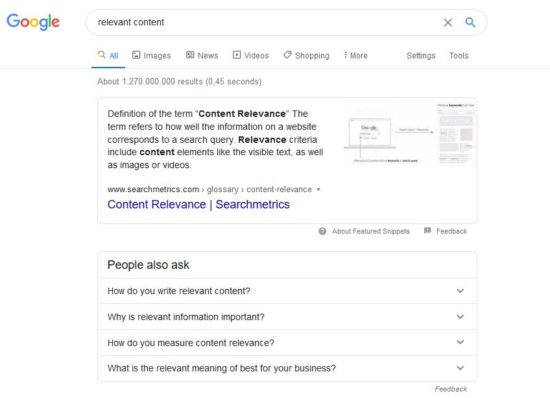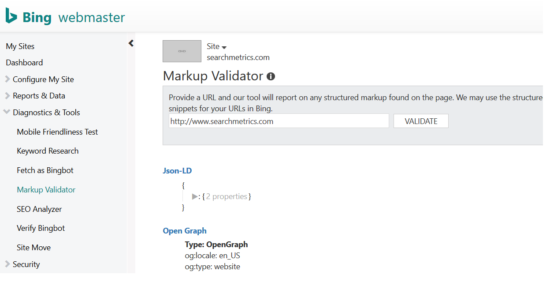Google’s Senior Webmaster Trends Analyst, John Mueller, says the importance of structured data for successful search engine rankings will continue to grow in the coming years. He recommends all webmasters to pay close attention to Schema.org markup. In this post, you’ll find useful tips on how to use markup and the best takeaways for SEO success with structured data in 2020.
Why not let us help you implement your SEO and content strategy? Get in touch with an expert from our Digital Strategies Group for an introductory consultation.
Schema.org, Structured Data and Rich Snippets: What’s What?
Before looking at structured data trends and tips, let’s review the basics. It’s not uncommon to see Schema.org, structured data and rich snippets all used in the same context, so we’ll shed some light on what’s what in the jumble of terminology.
Schema.org markup came about as a result of search engines such as Google, Microsoft, Yahoo and Yandex joining forces to develop a unified markup language to be used in a website’s source code. The markup for structured data can be used by SEOs and webmasters to provide additional information that helps search engine crawlers to better understand the type of content on a webpage. If a crawler can understand the content of a landing page easily thanks to markup, the page can have a higher chance of ranking better.
When Schema.org markup is used, it can result in additional information displayed in the search engine results pages, this information is called ‘rich snippets’. Structured data can generate enriched search results in Google, Bing or Yandex which can include business information like contact data and logo, local directory listings, events and exhibitions, news, articles, product information, customer ratings and reviews, breadcrumbs, FAQs and instructions, jobs, recipes, videos or the markup of ‘read aloud’ language assistant text as what has been termed ‘speakable’ structured data. Further information can be found on the Schema.org website and graphically on Google’s “Search Gallery”, which features a multitude of examples of structured data source code plus a preview of how structured data looks in the search results.
Google on Structured Data: “In the near-term future we will have more types of structured data”
“I think in the future, at least in the near-term future, we will have more types of structured data markup and it will continue to get more complicated…,” predicts Google’s Senior Webmaster Trends Analyst, John Mueller in one of his January 2020 Google Webmaster Hangout -Sessions. Why is he so certain of that? Mueller goes on to say, “I suspect it’ll get harder in the near future, at least, maybe in the really long term it’ll be like ‘Oh, the machine intelligence can figure it out for you, you just write a text file and everything else will happen automatically’. But I can’t see that happening in the next couple of years.”
Although the BERT update has already taken a big leap forward with semantic understanding of content, especially with English language search requests, in a podcast with Search Engine Journal, Mueller mentioned that other languages have further to go. “In other languages, we are not nearly there yet, for example, Hindi.” Without structured data, the algorithm calculating relevant search results would have to rely more on keyword analysis – the old-fashioned way.
“Many pages on the web are still not very well optimized,” Mueller states and is sure that “the markup issue will continue to grow in the near future, and it will not become easier for webmasters.” This means webmasters should take an interest in JSON-LD. Take a look at the Google Webmaster Hangout Session below for more of what he has to say:
For today’s search results landscape, Mueller sees three types of structured data that are relevant to webmasters:
- Structured data as a fundamental requirement for specific features in search results: This applies, for example, to recipe tags, where Google displays several additional elements such as cooking time, ratings, and images in the search results. Websites with a local reference should also use all available structured data markup.
- Structured data for specific highlight elements in the search results: Take for example the markup for ‘how to’ instructions, FAQs or ratings – these are extra elements that can enrich classic organic search results and can make the search result more eye catching and can therefore improve the CTR.
- Structured data for voice assistance: This means that a website section of a webpage can be marked as ‘speakable’ structured data.
Structured Data Advice
Based on John Mueller’s remarks and our own experience here at Searchmetrics with structured data, we are able to define three key pieces of advice:
1. Always use Markup
Even if your pages only show standard blue title and description in the SERPs, integrating Schema.org markups can make a big difference. According to John Mueller’s explanation, even when Google search engines don’t display rich snippets, they are likely to still evaluate the structured data on the landing page in order to better understand the content.
The more Schema.org markup a website has, the easier it is for search engine crawlers to understand the content of a landing page and, as a result, reward it with better, more fully fledged results.
Local businesses such as restaurants, venues or dental surgeries, for example, can benefit a lot from markup. Things like opening hours, events, functions, reservations, address, and more, all help to influence how Google and other search engines understand and list your business!
2. Embrace Trends
The current 2020 trend for Coronavirus-related structured data is a perfect example of a trend. There are new markup standards introduced to inform of cancelled or postponed events, changed opening hours or special announcements, such as regulations about COVID-19.
Another current Google trend is one which has been ongoing and promised for several months now, is the possibility to markup ‘How to’ and ‘Frequently Asked Questions’. The benefit of this is, if you include this in your markup, you can potentially dominate a very large portion of the search engine results pages.
In tihs example, the Searchmetrics glossary is displayed as the first search result with corresponding questions and answers as an accordion for “relevant content“:

3. Be Aware of Frequent Changes
Google frequently changes the way they handle markup, plus Schema.org is being constantly updated and developed. For example, in September 2019, Google changed the way the algorithm handles review markup – since then, organizations or local companies can no longer display their own ratings as rich snippets in Google search results. However, displaying your own ratings still works in Bing and so many webmasters continue to use the ‘ratings’ markup, as the star rating can have a positive effect on the click through rate (CTR) in Bing search results. Note that organic traffic coming from Bing should not be overlooked – in the US, the Microsoft search engine accounted for over 6.5 percent of all desktop search queries in 2020 so far.
4 Tips for Integrating Structured Data
1. What structured data should I use, exactly?
First, check the search result pages for your relevant keywords. Look at the structured data that Google and other search engines display as rich snippets for your niche. If you notice that your competitors use a certain markup making them stand out in the search results, you can try to use this strategy yourself and generate rich snippets for your own pages in the search results.
In addition to checking search results pages individually, you should also check competitor sites by using Google’s Structured Data Testing Tool. This will reveal the markup that has been built into the competitors’ website code.
However, proceed with caution and be sure not to implement fake markup. For example, if you don’t publish recipes on your website, there is no point in marking content elements as a ‘Recipe’.
As a side note, cooking and recipe websites are one of the pioneer industries when it comes to rich snippets – just look at the search results and notice the variety of additional markup for keywords such as ‘pumpkin soup’:

2. How do I integrate structured data into my website?
There are several different ways to implement markup in your website code. According to Google, JSON-LD and Microdata are preferred. Google explicitly recommends the use of JSON-LD. Structured data can be added in several different ways; dynamically with JavaScript, or via plugins in the CMS, or added to each individual page.
For the sake of covering all possibilities, there are two other ways – when using the microdata option, structured data is added inline in the code in the appropriate line of HTML code of the page. The third variant, RDFa, has not been supported by Google since April 6, 2020.
JSON-LD implementation can be done in a variety of ways. URLs can be changed individually or you can use plugins or scripts that apply the code with a bulk rollout. The method chosen depends on both site structure and the markup. For example, if for an information-heavy website, you might be able to use markup for content organization, articles or authors on all site URLs. Alternatively, if you would like to markup specific landing pages for products or how-to instructions, you will have to work on the individual URL.
The Yoast SEO plugin for WordPress is an example of a free tool that will automatically add some markups for structured data. There are other free tools on the market that generate markup script automatically. Google offers the Data Highlighter tool in Google Search Console, which gives the option of defining website URL clusters, plus the ability to directly markup content elements with relevant markup.
3. How do I test the structured data?
After implementation, testing whether Google and other search engines ‘understands’ your markup is a critical step. Major search engines offer validation and testing tools for this purpose.
Google – Google has the Structured Data Testing Tool which is useful for checking that structured data has been correctly implemented. In addition, in the main menu of Google Search Console under the menu option “Enhancements”, you can perform a check for several kinds of markup as well as error monitoring, for example for reviews, sitelinks, FAQs or breadcrumbs.

Bing – Bing also offers a tool for markup testing, the Markup-Validator in Bing Webmaster Tools.

4. How do I check the results?
When you have added markup, a manual check of your own snippets for relevant keywords in the search results can help verify that it is working.
When will Google or Bing display my snippets? As a rule, these should display immediately after integration, validity testing and submitting a new crawling request for the corresponding URLs in Google Search Console or Bing Webmaster Tools.
We recommend checking both Google and Bing since the two search engines still differ as to which markups are displayed as rich snippets. While Google has drastically reduced the number of star ratings in search results since September 2019, star ratings are still often shown in Bing search results.
Post implementation, you can also check Google Search Console or Bing Webmaster Tools whether the click through rate (CTR) has improved as a result of the rich snippets.
Would you like to put your SEO knowledge into practice? Then arrange a demo of our Searchmetrics Suite today:
